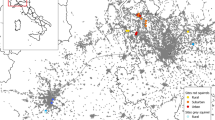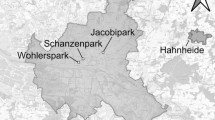Abstract
Fox squirrels in an urban environment had an average litter size of 2.83 (95% CI 2.5, 3.16) which was similar to rural populations. Nonetheless, the proportion of squirrels reproductively active during the summer/fall breeding season (0.73) and annually (spring + summer/fall) was higher (1.23) than previously recorded for non-manipulated rural populations. The average monthly survival rate (\(\mathop S\limits^ \wedge = 0.960\)) of urban juvenile fox squirrels during the first 14 weeks of life was higher than reported for adult populations in the area. High rates of reproduction and juvenile survival yielded high juvenile to adult ratios (juveniles/adults) averaging 0.44. Retention of juveniles after 6 months (15%) was significantly less (χ 2 = 7.24, p = 0.0071) than adults/subadults (40%). Results suggest that the urban environment provides quality habitat for fox squirrels and fox squirrels in urban environments have the potential to be a source population for surrounding suburban and rural environments.
Similar content being viewed by others
References
Adams CE (1984) Diversity in fox squirrel spatial relationships and activity rhythms. Tex J Sci 36:197–203
Adams LW (1994) Urban wildlife habitats; a landscape perspective. University of Minnesota Press, Minneapolis, Minnesota
Adams LW, VanDruff LW, Luniak M (2005) Managing urban habitats and wildlife. In: Braun CE (ed) Techniques for wildlife investigations and management. Allen, Lawrence, Kansas, pp 714–739
Adams CE, Lindsey KJ, Ash SJ (2006) Urban wildlife management. Taylor and Francis, Boca Raton, Florida
Allen DL (1942) Populations and habits of fox squirrels form Allegany County, Michigan. Am Midl Nat 27:338–379. doi:10.2307/2421005
Animal Care and Use Committee (1998) Guidelines for the capture, handling, and care of mammals as approved by the American Society of Mammalogists. J Mammal 79:1416–1431
Baumgartner LL (1940) The fox squirrel: its life history and management in Ohio. Ohio State Univ Release 138:1–17
Beckman JP, Berger J (2003) Using black bears to test ideal-free distribution models experimentally. J Mammal 84:594–606. doi:10.1644/1545-1542(2003)084<0594:UBBTTI>2.0.CO;2
Brown LG, Yeager LE (1945) Fox squirrels and gray squirrels in Illinois. Illinois Nat Hist Surv Bull 23:449–536
Etter DR, Hollis KM, VanDeelen TR et al (2002) Survival and movements of white-tailed deer in suburban Chicago, Illinois. J Wildl Manage 66:500–510. doi:10.2307/3803183
Flyger VF (1974) Tree squirrels in urban environments. In: Noyes JH, Progulski DR (eds) Wildlife in an urbanizing environment. Planning and resource development series 28. Holdsworth Natural Recourse Center, University of Massachusetts, Amherst, Massachusetts, pp 121–123
Gehrt SD (2004) Ecology and management of striped skunks, raccoons, and coyotes in urban landscapes. In: Fascione N, Delach A, Smith M (eds) People and predators: from conflict to conservation. Island, Washington, DC, pp 81–104
Gliwicz J, Goszczynski J, Luniak M (1994) Characteristic features of animal populations under synurbanization—the case of the blackbird and striped field mouse. Memorab Zool 49:237–244
Goodrum PA (1967) Tree squirrels investigations. Tex Game Oyster Com Rep 2:50–52
Hansen LP, Nixon CM (1985) The effects of adults on the demography of fox squirrels (Sciurus niger). Can J Zool 63:861–867
Hansen LP, Nixon CM, Havera SP (1986) Recapture rates and length of residence in an unexploited fox squirrel population. Am Midl Nat 101:209–215. doi:10.2307/2425856
Harnishfeger RL, Roseberry JL, Klimstra WD (1978) Reproductive levels in an unexploited woodlot fox squirrels. Trans Ill State Acad Sci 71:342–355
Herkert JR, Nixon CM, Hansen LP (1992) Dynamics of exploited and unexploited fox squirrel (Sciurus niger) populations in the Midwestern United States. In: McCullough DR, Barrett RH (eds) Wildlife 2001: populations. Elsevier, New York, pp 864–874
Koprowski JL (1994) Sciurus niger. Mamm Species 479:1–9
Korschgen LJ (1981) Foods of fox and gray squirrels in Missouri. J Wildl Manage 45:260–266. doi:10.2307/3807899
Krebs CJ (2001) Ecology. Benjamin-Cummings, San Francisco, California
Lopez RR, Silvy NJ, Frank PA et al (2003) Survival, mortality, and life expectancy of Florida key deer. J Wildl Manage 67:34–45. doi:10.2307/3803059
McCleery RA, Lopez RR, Silvy NJ et al (2007) Habitat use of fox squirrels in an urban environment. J Wildl Manage 71:1149–1157. doi:10.2193/2006-282
McCleery RA, Lopez RR, Silvy NJ et al (2008) Fox squirrel survival in urban and rural environments. J Wildl Manage 72:133–138. doi:10.2193/2007-138
McCloskey RJ, Vohs PA (1971) Chronology of reproduction of the fox squirrel in Iowa. Proc Iowa Acad Sci 78:12–15
McCloskey RJ, Vohs PA (1977) Accuracy used to determine age of fox squirrels. Proc Iowa Acad Sci 84:32–34
Nilon CH, Pais RC (1997) Terrestrial vertebrates in urban ecosystems: developing hypotheses for Gwynns Falls Watershed in Baltimore, Maryland. Urban Ecosyst 1:247–257. doi:10.1023/A:1018539914706
Nixon CM, McClain MW, Donohoe RW (1975) Effects of hunting and mast crops on a squirrel population. J Wildl Manage 39:1–25. doi:10.2307/3800460
Ott RL (1993) An introduction to statistical methods and data analysis, 4th edn. Duxbury, Belmont, California
Packard RL (1956) The tree squirrels of Kansas: ecology and economic importance. Misc Publ Mus Nat Hist Univ Kans 11:1–67
Peterson MN, Lopez RR, Frank PA et al (2004) Key deer fawn response to urbanization: is sustainable development possible. Wildl Soc Bull 32:493–499. doi:10.2193/0091-7648(2004)32[493:KDFRTU]2.0.CO;2
Pickett STA, Cadenasso ML, Grove JM et al (1989) Urban ecological systems: linking terrestrial ecolical, physical, and socioeconomics. Annu Rev Ecol Syst 32:127–157. doi:10.1146/annurev.ecolsys.32.081501.114012
Pollock KH, Winterstein SR, Bunck CM et al (1989) Survival analysis in telemetry studies: the staggered entry design. J Wildl Manage 53:7–15. doi:10.2307/3801296
Prange S, Gehrt SD, Wiggers EP (2003) Demographic factors contributing to high raccoon densities in urban landscapes. J Wildl Manage 67:324–333. doi:10.2307/3802774
Proudfoot GA (1996) Miniature video-board camera used to inspect natural and artificial nest cavities. Wildl Soc Bull 24:528–530
Samuel MD, Fuller MR (1996) Wildlife radiotelemetry. In: Bookhout TA (ed) Research and management techniques for wildlife and habitats. Allen, Lawrence, Kansas, pp 370–418
Simonoff JS (2003) Analyzing categorical statistics. Springer, New York
Steele MA, Koprowski JL (2001) North American tree squirrels. Smithsonian Institute, Washington, DC
Thompson DC (1978) Regulation of the northern gray squirrel (Sciurus carolinensis). Ecol 59:708–715. doi:10.2307/1938774
Weigl PD, Steele MA, Sherman LJ et al (1989) The ecology of fox squirrels (Sciurus niger) in North Carolina: implications survival in the southeast. Bull Tall Timbers Res Stn 24:1–93
White GC, Garrott RA (1990) Analysis of wildlife radio-tracking data. Academic, San Diego, California
Acknowledgements
I would like to thank Roel R. Lopez and Nova J. Silvy for their support during this project. I am also grateful to the anonymous reviewers of this manuscript whose constructive criticism and editing suggestions greatly improved it. Thanks are extended to the undergraduate students whose hard work and dedication made this project possible. I also want to make a special note of the contributions of S. Kahlich, and L. Gallant, whose countless hours trapping and tracking fox squirrels made them invaluable. Funding and support was provided by the Ed Rachel Foundation and the Texas Agricultural Experiment Station.
Author information
Authors and Affiliations
Corresponding author
Rights and permissions
About this article
Cite this article
McCleery, R.A. Reproduction, juvenile survival and retention in an urban fox squirrel population. Urban Ecosyst 12, 177–184 (2009). https://doi.org/10.1007/s11252-008-0074-7
Published:
Issue Date:
DOI: https://doi.org/10.1007/s11252-008-0074-7




